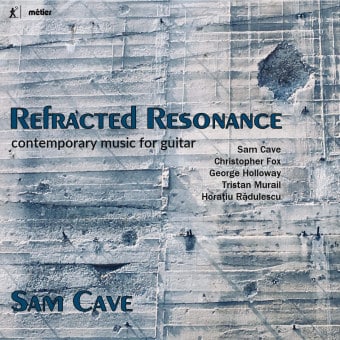Sam Cave is a young English guitarist who studied at London’s Royal College of Music. He is also a composer; one of his original works, albeit a brief one—less than three minutes long—closes this CD. It is part of an as yet incomplete set of “short meditative pieces.” In it, he uses some of the compositional technique and concepts found in the works by other composers on this CD, so it is a nice “summing up,” if you will, of what came before.
Many guitar CDs are predictable. That is not always a bad thing, but Refracted Resonance is not predictable. If you are looking for a restful hour of music in a Spanish or Latin vein, with perhaps some Baroque delicacies thrown in, then you will not find it here. All of the music here is challenging, not just for the performer but for also the listener. That is signaled right from the get-go by the inclusion of a work by Tristan Murail, the French composer familiar for his use of Spectralism, a compositional technique that uses the mathematical analysis or mathematical generation of timbre. (It should be said that just as some composers associated with Minimalism do not like to be called Minimalists, some composers associated with Spectralism do not like to be called Spectralists. I do not know if Murail is among that group.) The features of Tellur include alternate tuning of the guitar, non-traditional ways of attacking the strings, and a flamenco-like rapid strumming of the strings to produce something close to a wall of sound. (My apologies to Phil Spector!) In Tellur, the boundary between what is considered to be music and what is considered to be noise is blurred … but of course all music is noise and all noise can be music, depending on your perspective.
The distinction between music and noise is further explored in the work by Horatiu Radulescu. As Cave writes in his booklet note, in Subconscious Wave “we hear the universe.” This work could be associated with Spectralism as well. The guitar’s strings have been “microtonally retuned to match certain overtones from the harmonic spectrum of the note C,” and the guitarist plays the work (sometimes bowing the strings, instead of plucking them) against a backdrop of taped digital sounds.
George Holloway (not to be confused with senior composer Robin Holloway) wrote and dedicated both of his sonatas to Cave. The first sonata also uses microtonal retiming of the guitar strings, this time, in Cave’s words, “to access certain ‘spectral’ harmonies that imitate the pitches of the harmonic series.” Two different “materials,” the first dominated by guitar harmonics and the second dominated by “normal” fretted notes and chords, “discourse” with each other over the course of eight minutes. The second sonata, simpler in its sound and its materials, was inspired by, and attempts to mirror, the “extraordinary calm and beauty” of a church in the nation of Georgia, which Holloway visited in 2011. The score includes what are described as “guide notes,” whose decay controls the pace at which other material is presented.
Chile, by Christopher Fox, also uses extended playing techniques, albeit with a political motivation. At different points in the 11-minute work, the guitarist mutes the strings, a metaphor for the repressive Pinochet dictatorship. Also, in Fox’s words, “The music’s fluctuation between more or less repetition—between phrases that move forward and phrases that close in on themselves—has a similar expressive purpose.”
I have no way to evaluate Cave’s performances, at least from a technical standpoint, but suffice it to say that his playing convinces me that all of these works are worthy of repeated attention, even though they hardly leap into the ears of the listener. This is not a CD to play while sitting by the fire¬side with a loved one, sipping on a glass of port. You know if this is for you, by now.
The documentation that accompanies this release is exemplary, as is the engineering.
@divineartrecordingsgroup
A First Inversion Company
Registered Office:
176-178 Pontefract Road, Cudworth, Barnsley S72 8BE
+44 1226 596703
Fort Worth, TX 76110
+1.682.233.4978












